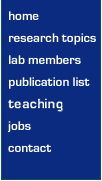    |
Review Of Our Current Research
 recent publications recent publications
As mentioned in the cover text, our research group is primarily interested in oxygen-dependent reactions with an impact on biomedicine. The most fascinating results were obtained from an investigation on the regulation of blood flow in heart and the vascular system. Under normal conditions the molecules nitric oxide (NO) and prostacyclin regulate vascular tone i.e. the relaxation of smooth muscle by the endothelium to allow blood flow without aggregation of blood cells like platelets and leukocytes (thrombus formation). We reported that in case of bacterial infections (endotoxemia) the endothelium produces superoxide radicals from oxygen which combine with NO produced also by the endothelium, and a new compound, peroxynitrite, is formed. We then noticed that under such conditions prostacyclin formation was reduced. Since superoxide had eliminated NO in favor of peroxynitrite the subsequent inhibition of prostacyclin formation caused diminished relaxation and even vasospasm due to the accumulation of an intermediate which has strong vasoconstriction properties. From this we derive that superoxide first eliminates NO, then the resulting product peroxynitrite inactivates prostacyclin synthesis and by this blockade generates a strong vasoconstriction factor. The molecular basis for the peroxynitrite effect was identified as a specific and fast nitration of a tyrosine residue at the active site of prostacyclin synthase. We were able to establish the mechanism by finding model systems of iron-complexes and peroxynitrite. Thus our findings have provided a basis for understanding a hitherto unknown mechanism in heart infarction, ischemia-reperfusion or even the vascular complications in diabetic patients.The synthesis of prostacyclin also occurs in kidney mesangial cells and also there the same reaction was found when proinflammatory stimuli like cytokines induced peroxynitrite formation in these cells. Ongoing studies confirm that nitrated prostacyclin synthase can be found under many pathophysiological conditions in most tissues indicating that this unusual chemical reaction has a broad significance for inflammatory or shock conditions.
Since such results indicated that the superoxide radical is of new and prime importance for pathophysiological events we have followed other reactions of susperoxide to prove the more general concept that redoxregulation as a key player.
With the phosphatase calcineurin we discovered that the ferrous iron-zinc cluster at the active site could be inactivated by superoxide. Since calcineurin is critical for the T-cell response we try to prove that oxidative reactions block the immune system by this mechanism. Such work can be related also with the ageing process which therfore comes into focus for our future plans. A "Forschergruppe" on "Immuno-Senescence" will be set up by serveral groups of Konstanz University.
A third project concerns a methodological approach to study biochemical mechanisms and drug actions without using living animals. This was achieved by preparing slices from rat lung and incubating them in physiological bath solutions. We found that the slices maintained viable over at least two hours and still show alveolar contractions under the microscope. Also biochemical functions were preserved so that from one rat lung up to twenty separate experiments could be performed. Thus our system could be used to save animal experiments and therefore was given a prize from the "Fondation internationale pour la substitution de l'experimentation animale".
Most of such studies were performed as projects of the former Graduiertenkolleg "Biochemische Pharmakologie" at Konstanz University in a team of chemists, biologists and physicians in order to have expertise in all disciplines involved. A new Graduiertenkolleg "Biochemische Wirkstoff-Forschung" includes also the local Altana Pharma Company and profits from scientific collaborations with industry. International collaborations with research groups in Italy, Spain, Japan, Great Britain, Russia and the United States are of mutual help to achieve our goals.
 recent publications recent publications
Last modified
by Daniel Frein |
|
|




